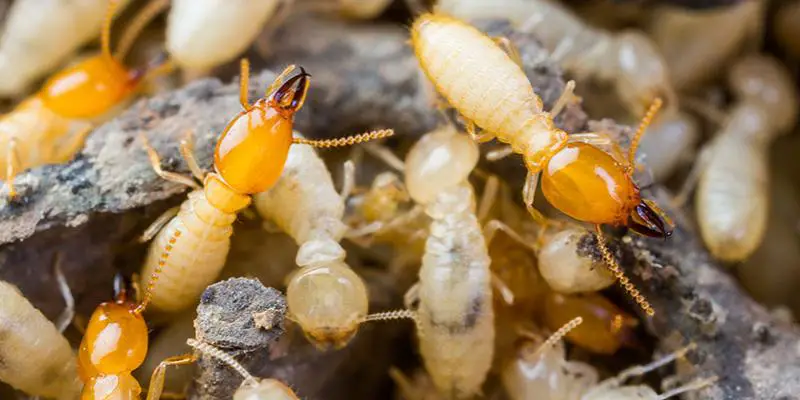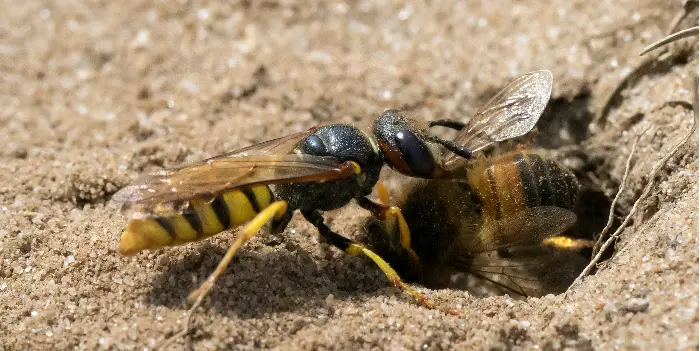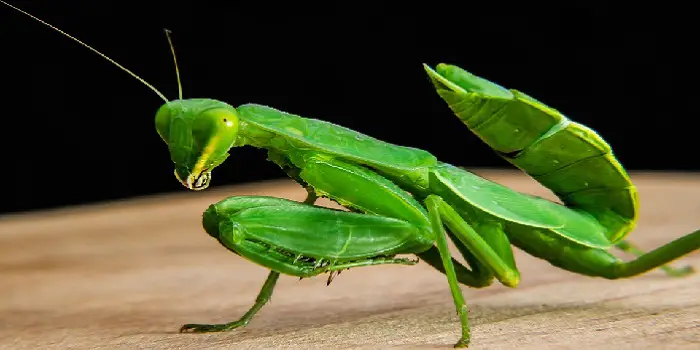
Wasps are insects that prey on small insects, and their interaction with people is often not so friendly.
Red wasps, in general, are considered to be a nuisance rather than a danger.
The only danger is their stings, which they often use to attack while defending themselves.
The problem can grow considerably when red wasps move into your attic or walls.
Removing them from your property means taking the proper safety precautions to protect you and your family.
What follows are the steps necessary that allow you to properly identify and remove the wasps from your home.
How Do Wasps Get into the Attic?
Wasps decide to build their nests in your attic, porch, or garage because of the safety they get there.
Queen wasp, when laying her eggs, needs a place that is secure and hence gets into your space through holes, gaps, or cracks.
Generally speaking, if you want to get rid of red wasps in your attic, you will need to kill them instantly in their nest.
The best time to kill them is early morning when they are inside their nest with minimum activity.
3 Easy Steps to Get Rid of Red Wasps
The very first step starts with identifying them properly so that you can use the effective treatment method.
1- Identification
Although you do not have to know the exact species, there are two types of wasps.
Those that build solitary nests in single pods just for their eggs.
And those that create larger, community nests hold all the group’s young.
The latter is easier to remove since you can get them all at once.
Solitary nests are generally smaller and maybe tougher to locate fully.
2- Get the Protection
Now that you have identified which type of wasps are in your home, the next step is donning the proper protection so you do not get stung.
Wasp stings can be quite painful, with some being poisonous, so care is needed to ensure that you are fully protected.
You can rent or purchase a wasp suit, but you can also use clothing that may be in your home, such as the following.
- Rain Suit made of Rubber
- Rubber Gloves
- Face Protection
Be sure to cover all areas of your body before attempting to remove the wasps.
3- Get a Wasp Spray or Wasp Bomb
Next, you’ll want to get the proper spray that will destroy the wasps and their nest in your attic.
It’s good to know that many wasp sprays have a long reach which means you can stand several feet away and still get the nest.
If there are several nests or you have a large nest on the floor, then a wasp bomb may work better.
To get rid of wasps using an aerosol wasp sprayer, you will need to follow the following steps:
a) Clear Away the Area
Before removing the nests for spraying, you’ll need to clear away the items in the immediate attic area.
You do not want them around to be sprayed as well, which may damage the items.
In addition, you may want to put down a sheet of plastic to catch any drips from the wasp spray that you are using.
Be sure to close any windows to reduce the airflow. This will maximize the effectiveness of the spray.
b) Spray and Let Dry
Now you are ready to spray the nest with a wasp spray.
You’ll want to cover it thoroughly. Once completed, let the poison soak into the nest for at least 24 hours.
The same is true if you are using a wasp bomb.
Check back to see if there are any live red wasps left and use the spray again if that is the case.
White vinegar, which is a natural and easy alternative to wasp spray, can also be used to kill the wasps if you do not want to use commercial chemicals.
Simply mix equal amounts of vinegar and water in a spray bottle and spray over the nests carefully.
c) Remove the Nest and Clean the Area
With all the wasps in the nest dead, you can now remove the nest and safely dispose of it.
Be sure to put it in a can or bag that can be sealed.
Once removed, you can now clean the area to remove any trace of the nest.
By removing all the wasps in your home, you discourage new wasps from entering.
Keep that in mind when you decide to get rid of wasps.
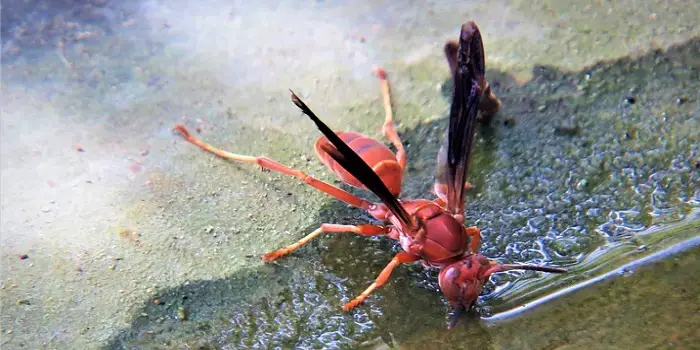
5 Methods of Removing Wasps Without Killing Them
If the wasps that have invaded your home need to be removed without harming them, then here are five proven ways to do the job.
1- Peppermint Oil
Arguably the best way to remove wasps is to keep them from setting up nests inside your home.
Wasps hate mint, and for this reason, they can easily be controlled using spearmint or peppermint oil.
You can use peppermint oil to spray around the places in your house where the wasps like to gather.
The scent of the oil repels them, and they will stay out of those places.
When using this method, care that you will need to reapply the essential oil from time to time as it will evaporate.
2- Pressure Washer
If you only have a few wasps, then fill a pressure washer with soapy water and spray the wasps.
The water will stick to their wings, so they cannot fly around.
You can then use gloves to pick up the wasps and place them in a container until they can be released.
It’s also possible to trap hornets and mosquitoes in the same way.
However, it generally only works when you just have a few of them. Larger numbers require another solution.
Also, remember, using too much dish soap and water solution mixture can kill the wasps instantly, especially when sprayed for a long directly over them.
So, make sure you do not spray very hard if you do not want to kill them.
3- Shop Vac
Put a little soapy water inside the shop vac, wear protective clothing, place the vacuum in a location where the wasps come and go, then turn it on for a few hours.
The vacuum will pull the wasps inside, while the soapy water will help keep them in place.
4- Solar Wasp Trap
This is a relatively simple device that traps the wasps using solar power.
The power provides heat and light, which attracts wasps to come inside, which traps them.
You simply need to add some sugar, such as syrup, to the inside of the jar. Have just enough to attract them, but not to drown them.
Empty the jar at a distant location, so the wasps do not find their way back to your home.
5- Sugar & Water Trap
This is a simple one that can trap wasps safely.
Start with a two-liter bottle, such as one that contained soda pop, and cut the upper part off.
Flip the upper part upside down, insert it into the lower part, and tape them together with duct tape.
Then, add a mixture of sugar, a little vinegar, and water to the lower part and set near the wasp nest.
The wasps will fly into the trap and will not be able to get out. You can then remove and empty the bottle when you like.
If you want to keep the wasps alive, then only use enough of the solution to attracting them, not drown them.
Seek Professional Help as a Last Resort
If you cannot locate the nest, you should call a professional.
They can locate the nests and remove them safely from your home.
There is no need to take chances by setting up traps only to have them not work because the nest is still around.
You can use all of these home solutions to wasps during the spring and summer months when they are the most abundant.
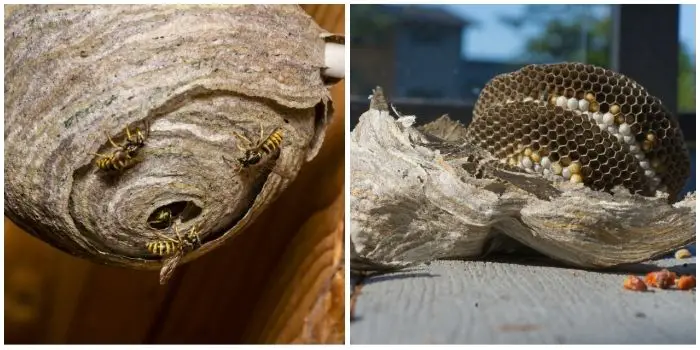
How to Identify a Wasp Nest in Your Attic?
The sight of what appears to be a wasp nest can strike fear into the hearts of most home and business owners.
However, while some wasps do pose a danger to those who live or work inside, there are other types of wasps that have little to no threat at all.
Understanding the difference will let you know what action to take (if any) when dealing with a wasp nest.
What follows are a few tips on how to identify a particular species of wasp depending on the nest that they construct.
1- Dirt Dauber Nest
The dirt dauber gets its name from the material used to create its nests.
The nests will be small mounds of mud cylinders that are normally found under the eaves of houses.
Most dirt daubers are large, are yellow and black or all-black in color, and have a strange, almost alien-like appearance.
Unlike most wasp species, dirt daubers are solitary and are not aggressive. You can remove a dirt dauber nest safely yourself.
But you may want to keep them around as they feast on spiders, particularly black widows.
2- Hornets Nest
Think of a bigger version of a yellow jacket with white stripes instead of yellow, and you have a typical hornet.
Although the nest of a hornet is also crafted with paper and can be round, they are generally quite large as well.
A typical hornet’s nest can be the size of a football or basketball and most often is located inside bushes, attics, and trees.
Like yellow jackets, you will need professional assistance to remove hornets’ nests as they can be quite aggressive.
This is especially true with the new breed of murder hornets, although they are really just somewhat more aggressive hornets.
3- Nest of Paper Wasp
As the name implies, these are wasps that appear to create their nest out of paper products and weathered wood.
You will generally find their round or umbrella-shaped honeycomb nests under the eaves of homes and businesses.
Sometimes you may also find them hanging under protected areas such as porches, railings, or tree branches in your yard.
Most such nests are generally smaller than your fist and maybe gray in color, looking a lot like Paper Mache.
While they may sting, this type of wasp is not very aggressive and poses little threat to you.
Also, most of the time, the constructed nests will last for only about a year until the colony of wasps abandons them in late autumn.
4- Nest of Yellow Jackets
These are often mistaken for bees as they have a similar color and stripes.
However, yellow jackets often bury their nests in the ground or inside the cavities of walls.
When seen, the nests will generally be round and appear to be crafted from Paper Mache.
Yellow jackets are quite aggressive and will sting those who get close to their nests.
It is advisable that you seek a professional pest control company to locate and remove their nests.
If you cannot identify the type of nest yourself, you should seek assistance from a pest control company or firm.
If you can take a picture of the nest, they should be able to identify the species.
As noted earlier, the dirt dauber is actually beneficial to your home and will rarely sting, so you may want to keep them around.
Other types of wasps you may want professional help to remove.
What Happens to Wasps When Winter Comes?
You may notice that when fall arrives the wasps are greatly reduced in numbers.
By the onset of winter, you will probably not see a wasp outdoors until the warmer temperatures of spring come the following year.
Although you may believe that the colder temperatures are responsible, the truth is that it is the lack of food that mostly kills the wasps.
Wasps in the Wintertime
Notice that while most of the wasps die, not all of them meet their demise because of the lack of food.
The male wasps are the ones that do not last through the winter because they have no food.
The queens can hibernate, which means they can survive for months in a dormant state.
However, while this means that the queens can survive the winter, they are quite vulnerable to spiders who find them a hearty meal during the otherwise cold months.
A queen wasp that manages to not be eaten by a spider is not out of the woods just yet.
If a false spring occurs when the temperatures rise just enough to wake them from hibernation, a freeze occurs again, which may kill off the queen.
Because of the high mortality rate of the queens, this is why wasps breed as they do.
Emerging into Spring
A queen wasp that survives into the early months of spring will lay a few eggs that will emerge as workers or sterile females.
Once mature, the queen will then lay more eggs which the workers will tend to as the nest grows.
It does take time before the food sources for the wasps will emerge, so the numbers stay small at this point.
The cooler temperatures also make it more difficult for the wasps to operate at full capacity.
Summer & Winter
By mid-summer, the queen will have created enough workers to tend to the needs of the nest when the males and fertile females are now born.
This is when the nest will reach its peak size. The males and new fertile females will grow while being attended to by the workers.
The new queens will leave in the early fall to mate with the males and create new nests in other places.
By the time winter arrives again, the old queens will tend to die off as well.
This leaves the new queens to hibernate and lay eggs in the early spring to start the process yet again.
It explains why wasps do not use the same nests over and over again.
The new queens create new nests for their young.
As they create more workers, the nests will grow over time as the cycle repeats year after year.

Other Related Questions:
Can red wasps kill you?
Wasps always sting you for a reason.
Normally they try this defense mechanism when they fear that they are in some kind of danger.
While being stung once by a wasp isn’t dangerous, if stung 30 to 50 times (or attacked by a large group of wasps together), it can possibly kill you.
What household item can kill wasps?
Other than those mentioned before, WD40, bleach solution, hairsprays, rubbing alcohol, boric acid, cinnamon, or simply boiling water can be effective alternatives for killing the wasps.
You can also use powdered deterrents such as diatomaceous earth (DE), talcum powder, and baby powder to kill and repel these insects.
You will just need to dust these powders near the exit of a wasp nest in your attic or inside a wall.
Does killing a wasp attract more of them?
When a wasp stings or die it releases a chemical that can be detected by other nearby wasps.
A dying wasp can therefore attract more of them to tell other wasps to be on the lookout.
Since these small little critters are good at recognizing and remembering faces, the more you try to quash them, the more they will come to take revenge.
The conclusion
Keep in mind that wasps contribute to the health of plants by consuming aphids, caterpillars, weevils, and grubs, which otherwise eat the pollen and other crops.
So, they do serve a purpose which is why their presence is needed in the wild.
However, this does not mean they are welcome in your home or attic.
If you want to stay away from them, you can use the above-mentioned prevention tips, or if you find them in a large number in your home, it’s best to kill them instead.

Welcome to ProShieldPest.com. I am Tina Jones. I have been working as a pest removal professional in Winslow, Arizona lately. At present, I love to spend my time with my family as a retiree.
Here I share all my knowledge and experiences to help people understand better how they can stop pests at their homes without actually killing them. Hopefully, the information you will find here will help in safeguarding your home! You can check more about me here.

